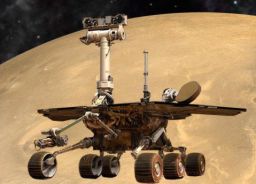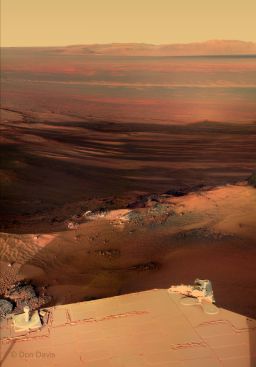A.J.S. Rayl • Feb 29, 2012
Mars Exploration Rovers Update: Opportunity Turns On, Tunes In, and Drops Panoramic Postcard to Earth
There's no hail or snow or sleet, though it is the depth of winter at Meridiani Planum and a cold unimaginable to us has gripped the landscape. But that hasn't stopped the Mars Exploration Rover Opportunity from showing her now-legendary mettle and marking the first full month of Year 9 as one to remember, if only for its routine.
Parked on the north end of Cape York on the rim of Endeavour Crater with an approximate 15-degree northerly tilt to soak up as much of the winter sunlight as possible, the solar-powered rover worked throughout the month of February, and Mars seemed to reward her last weekend with a gust or two of dust-clearing winds noticeably boosting her power levels to nearly one-third of full capacity.
"Life is good," Steve Squyres, MER principal investigator, of Cornell University, said during an interview earlier today. "We're just continuing with the essential tasks before us, waiting for spring. We've caught a couple of wind gusts, and life is good."
For the assigned winter science campaign, the robot field geologist turned on "the radio," aiming her high gain antenna direct to Earth to track the dynamics of Mars' spin in a study that may reveal for once and for all if the planet's core is liquid; tuned her iron-detecting Mössbauer spectrometer to a portion of bedrock to try and get at what's inside; and "dropped" the rest of the principal frames for the next 360-degree panorama into the data stream to Earth, as well as took care of the sol-to-sol business that comes with being a robot.
Even though winter is in full force, Opportunity still had the time and power to go above and beyond her call of duty and focused her panoramic camera to take a bunch of close-up images of the bedrock on which she is parked, as well as more dramatic, late afternoon photographs of the Martian landscape that surrounds her.
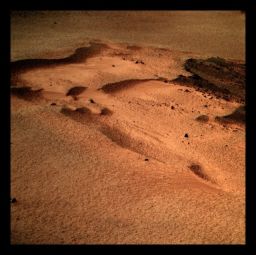 Endeavour dunes
Endeavour dunesOpportunity used her Pancam to take the pictures that Stuart Atkinson of UMSF.com colorized here. This view shows the rover's current view of the Endeavour dunes along the edge ofCape York and Endeavour Crater, an are some have nicknamed the 'North Pole.' For more of Atkinson's work visit: http://roadtoendeavour.wordpress.com/
Credit: NASA / JPL-Caltech / Cornell / S. Atkinson
"It was business as usual … a pretty easy month," assessed Ray Arvidson, of Washington University St. Louis, MER deputy principal investigator, who is overseeing the rover's winter science campaign.
This Martian winter – the fifth for Opportunity – is the first winter this rover has had to find a northerly slope, angle its solar arrays to the Sun, and park for a period of months, conducting its science research from that solitary position. Opportunity's twin, Spirit, by comparison, knew the routine well, and struggled every winter just to survive. And by most all accounts, the last Martian winter is what likely took the sunlight from Spirit's sails.
"We were never going to be in a Spirit-like situation [with Opportunity this winter], but we're always concerned because [one] never knows," said John C. Callas, the MER project manager, of the Jet Propulsion Laboratory (JPL), from which the rover is being commanded. "The atmosphere could get worse. The dust factor could get worse. Instead, things have been stable. Things are good," he agreed.
Opportunity is a little closer to the equator than Spirit is. That "little closer" matters. Although the freeze of the season slowed the pace of the rover's work a bit as February got underway, the rover itself didn't seemed phased. "We are in very good shape for this time of year," summed up Bill Nelson, chief of the rover engineering team at JPL. "It looks like we'll get through this winter without undue problems. All in all, there isn't much to complain about."
Except that is, that darn dust. Opportunity is wearing a thick enough coat of the fine powdery stuff to blend right into the terrain. The thicker the Martian dust on the rover, the less sunlight penetrates the arrays. That translates to less power generated by the rover, and the science team has its hopes and Opportunity's site set on locations and discoveries a few good drives to the south. Road trips require energy and so team members had been hoping for a swift gust or two or three to "dust" the robot and enable her to power up for the scientific expedition that awaits.
Historically, Mars' array cleaning wind gusts come after winter, in the spring. But Opportunity is in new terrain and as this mission's luck would have it, Mars whipped up a gust or two last weekend, giving the rover a bump that pushed her power levels to about one-third full capacity. Now, all fingers are crossed that Mars will help March blow in with something of a little gusty roar.
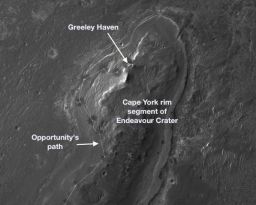 Greeley Haven on the map
Greeley Haven on the mapOpportunity will spend its fifth Martian winter working at Greeley Haven. This site features an outcrop near the northern tip of the Cape York segment of the western rim of Endeavour Crater. It provides a north-facing slope of 15 degrees or more to help maintain energy output from the rover's solar array. It also presents geological targets of interest for investigating during months of limited mobility while the rover stays on the slope.Credit: NASA / JPL-Caltech / UA
In coming sols, Opportunity will confront the coldest, shortest sols of this, its fifth, Martian winter. "We can see the minimum energy point just ahead, and our expectation is that once we get through that point things will gradually begin to improve," said Callas.
"The date that really counts [for Opportunity] is March 9th, minimum insolation at the top of atmosphere," offered Arvidson. That will be the day of the least sunshine. "And then winter solstice in the southern hemisphere of the Red Planet where the MERs are located, is March 31st." That is, much like on Earth, the shortest sol or Martian day of the Martian year.
Opportunity, meanwhile, is keeping busy. It may be indescribably cold and the robot may be parked, but, one might say, no moss is growing on this roving stone. Along with the primary assignments of the winter science campaign, the rover is currently producing enough energy to take more photographs, including close-ups of the foreground, close-ups of chosen spots to monitor terrain changes caused by wind, and more of those Ansel Adams-like artistic low-light, end-of-the-day landscape photographs, as well as the usual routine engineering tasks. "We don't lack for things to do," said Nelson.
Just how long Opportunity will remain parked once winter solstice has passed and the temperature, the Sun, and the power levels rise higher is an unknown proposition at the moment. "Considering all aspects, it's pointing right now to a six-month stay," Arvidson hazarded.
Squyres, not surprisingly, was less committal. "This is quiet season. We know that," he said. "We don't know when we'll be able to drive away yet. We're certainly not ready to go anywhere right now. The radio science work has been going really well. It's been a big success story so far. But these recent [energy] trends have been positive and we're encouraged." [The MER Update reported on the radio Doppler experiment in last month's edition.]
For now, driving is nowhere to be seen on Opportunity's agenda, and for the next couple of months the rover will likely continue working on the winter science campaign from its parked position.
"I'm glad this winter is not as bad as first feared," reflected Nelson, speaking no doubt for everyone on the team. "Although," he added quickly, "you never want to relax your guard with Mars."

The Guide
"Somesol a so-tired tour guide
Will lead vacationing families
To this place one final time,
Their faces beaming behind gold-plated visors -
Some sun-starved and pale,
Betraying their Martian birth ..."
This artistic image, created by Stuart Atkinson from some of Opportunity's Pancam bounty with a little special effects accompanies Atkinson's latest astropoem, The Guide, which he introduced and which is available on his Road to Endeavour blog. The scene here simulates a human visitor or guide looking out over what the rover Opportunity is currently looking out, with a little Earthling flourish.
Credit: NASA / JPL-Caltech / Cornell / S. Atkinson
In planetary news: Mars reached aphelion, the farthest point in its orbit from the Sun – about 249,209,300 kilometers or 154,851,480 miles – on February 15th.
Opposition, the closest Mars comes to Earth in its orbit (since 26 months ago), is Saturday, March 3rd. Even through moderate sized backyard telescopes, you should be able to see views of the polar caps and other major features on the Red Planet, although you will not be able to see either Spirit or Opportunity.
Opportunity from Meridiani Planum
Opportunity spent the month of February 2012 hunkered down on the northern end of Cape York along the rim of Endeavour Crater, parked on Saddleback, a portion of bedrock believed to be part of Shoemaker Ridge, working on her winter science campaign, and other science assignments as time and energy permitted.
From her parked position, the rover conducted a cool dozen radio Doppler tracking measurements this month in a study of the geo-dynamics and orbiting characteristics of the planet that may determine at long last if the planet's core is liquid, along with many hours of in-situ or contact science investigations of the bedrock target, Amboy, and hours taking dozens of pictures with both its microscopic imager (MI) and panoramic camera (Pancam). In fact, the robot field geologist finished "principal photography" on the MER mission's next 360-degree panorama this month, named in honor of MER science team member Ron Greeley, who passed away last October.
On Sol 2852 (February 1, 2012), Opportunity used her MI to take a series of close-up pictures for what will be an up-close-and-personal, detail-rich mosaic of Amboy. Then, the robot field geologist placed her Mössbauer spectrometer on Amboy for a multi-sol integration, utilizing new parameters instituted last month to optimize the spectrometer's performance.
The Mössbauer, like everything else on the rover, including the rover herself, is operating well beyond its expected "lifetime." Since the Mössbauer features a radioactive power source that has been steadily fading since it was put into operation back in 2004, its data have been getting progressively weaker, and then last month the instrument began acting up.
"Our mission was designed for 90 sols, and the half-life for the radioactive source in the Mössbauer is about 270 days," informed JPL's Albert S. Yen, MER science team member who works on both the Mössbauer and alpha particle X-ray spectrometer (APXS) teams. "Here we are on Sol 2880. We are more than 10 half-lives into this mission. So the source life is down by between a factor of 1000 and 2000. What would have taken us 30 minutes at the beginning of the mission in terms of data integration time now takes 750 hours or so."
Basically, what's happening is the signal is getting weaker and weaker, and that makes it harder and harder for the team to distinguish genuine Mössbauer signals from all the other distracting, intersecting signals, and the stuff of white noise. The MER team doesn't have the time or desire to position the Mössbauer on Amboy for 750 hours and so ...
"As you might imagine we are looking at all kinds of tricks to try and increase our signal-to-noise without having to sit here for that period of time," said Yen.
One thing they have done is adjust the parameters in which Opportunity operates the instrument "to be more consistent and compatible with the environment the rover is operating in," said Yen. "We have separated the output from our detectors so we can isolate the good signal a little bit better. We have played with the drive velocity range so that we can get better performance out of the instrument. And we're going to try a while longer."
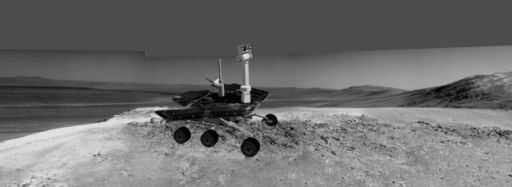 Simulation of Opportunity at Greeley Haven
Simulation of Opportunity at Greeley HavenMichael Howard, the creator of the heralded Midnight Mars Browser software, put together this simulated image of Opportunity. It shows the rover in her (approximate) winter parked position at Greeley Haven, which is located on the northern end of Cape York.
Credit: NASA / JPL-Caltech / M. Howard
On Sol 2853 (February 2, 2012), Opportunity turned on her high gain antenna (HGA) and conducted her first radio Doppler tracking pass of the month. Although power levels were prohibiting the rover from conducting both an afternoon ultra high frequency (UHF) relay pass to downlink data on the same sol as a radio Doppler pass, with a little help from the highly skilled operations team, capable of performing energy trades on the tactical timeline in a single bound, the rover managed to conduct two more radio Doppler tracking passes, on Sols 2855 and 2856 (February 4 and 5, 2012), for a total of three during the first week of February.
Opportunity finished out the first week of February on Sol 2858 (February 7, 2012) continuing work on the MI mosaic campaign of Amboy and carrying out the host of routine tasks. Amboy was chosen for an in-depth investigation because the MER scientists believe Saddleback, where Amboy is located, is part of Shoemaker Ridge, the geologic formation that has been described as the "spine" of Cape York; thus, Amboy is representative of the bedrock at Cape York.
Even with the depths of Martian winter settling on Endeavour Crater, Opportunity maintained a respectable amount of power during the early part of the month, with levels fluctuating between 270 watt-hours and 283 watt-hours. Better still, the skies overhead continued clearing and the atmospheric opacity or Tau hovered around a slightly hazy 0.679. The rover's solar array dust factor moved from 0.469 and 0.478 as the Tau improved.
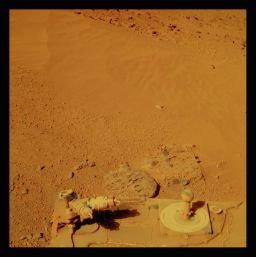 Blending in
Blending inOpportunity took this picture with her Pancam this month and Stuart Atkinson of UMSF.com colorized it. It shows The Planetary Society's MarsDial. The motto on the MarsDial is: Two Worlds, One Sun. The primary function of the dial is as calibration target for the high-resolution, stereo Pancam. Notice how the rover nearly blends into its landscape, a part of Mars.
Credit: NASA / JPL / Cornell / S. Atkinson
Opportunity kept her robot "nose to the grindstone" throughout the second week of February, conducting two radio Doppler tracking passes, on Sols 2861 and 2863 (February 10 and 12, 2012); working on the close-up, MI mosaic campaign of Amboy; completing the final segment of the 360-degree Greeley Panorama; and checking off other routine chores.
Opportunity began the third week of the month on Sol 2866 (February 15, 2012) – the same sol that Mars reached aphelion or its farthest distance from the Sun – pressing on with her winter science campaign … taking photographs of the foreground with the Pancam for the detailed mosaic to accompany the Greeley Panorama … conducting a late afternoon radio Doppler tracking pass … again placing the Mössbauer on Amboy for a very long (multi-sol) integration.
On 2870 (February 19, 2012), Opportunity conducted another radio Doppler pass; took more pictures with the Pancam for the foreground Greeley Pan mosaic; and continued the Mossbauer integration on Amboy. The next two sols were much the same, except, instead of tuning in for radio Doppler passes, the rover downlinked stored data to Earth via UHF and Mars Odyssey.
The jury is apparently still out on whether the Mössbauer is going to be able to glean much of anything of Amboy's iron content or composition. "It's too early to say at this point," Squyres said today. "We're still thinking at this point that using the instrument is the sensible thing to do. We'll see what Mars gives us. It takes a long, long time to build up a measurement and we haven't built up enough to do a good assessment yet. We're going to be taking a look at this on an ongoing basis. Every week or two, we sit down and say: 'How we doin'? Should we keep goin'?' And the answer so far has been: 'Yes, keep going.'"
"We're doing the best we can to collect the data that we want to go after this question of phyllosilicates or iron-bearing phases in these rocks," Yen added.
Interestingly, the APXS is "on the other side of the spectrum," Yen said. "We actually do better now than we did at the beginning of the mission, because the Mössbauer source isamong the major contributors to the APXS background signals. Now, with the Mössbauer source decayed, the APXS is a very happy instrument." Still, for te time being, energy continues to be a precious resource and the team decided to "dedicate our time to the Mössbauer in the daytime to try and get that signal up a little big stronger," yen said.
As the last week of February got underway, the robot field geologist seemed to pick up the pace, taking more pictures of Kitty's Gap, a target near Amboy, with her MI; and collecting a series of Pancam pictures of Coonterunah, the foreground area directly east on Sols 2873 and 2874 (February 22 and 23, 2012). Then, on Sol 2875 (February 24, 2012), Opportunity – Martian winter an all – packed in a full sol's work, checking out Amboy (or trying to anyway) with the Mössbauer; taking more Pancam pictures for the foreground Greeley Pan mosaic; snapping some additional 13-filter Pancam pictures of a spot dubbed Duffy, just to her east; in a new campaign to monitor spots close-up in to look for changes due to wind; conducting another radio Doppler pass; and linking with Mars Odyssey to downlink its bounty of data.
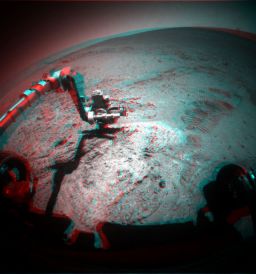 Digging in to Year 9 in 3D 9
Digging in to Year 9 in 3D 9Get your blue-red glasses. This simulated 3D image show Opportunity's current workspace. The rover is checking out a rock target called Amboy on bedrock dubbed Saddleback. The solar-powered rover is parked on a north-facing slope at the northern end of Cape York, along the rim of Endeavour Crater, soaking in as much of the winter sunlight as possible.Credit: NASA / JPL-Caltech / Cornell / S. Atkinson
From all appearances, Opportunity was tracking pretty well with the predictions in February. "If anything, the rover is just slightly, maybe 5 to10 watt-hours, better than predict," Nelson had reported at the top of this week.
The assumption was that the rover's power levels power levels would continue to decrease at least for the next couple of weeks, and then rise as spring moved in – unless a gust of wind turned up to "dust" the rover's solar panels. Something team members had been hoping for.
Well, Mars delivered, blowing Opportunity a gusty "kiss" or two last weekend, and gifting the rover with a small but measurable bump in energy. "We're above 300-watt hours for the first time [about one-third full power] in 70-plus sols, and that's good news," said Squyres.
"Slow dust cleaning was noted beginning on Sol 2877 (February 26, 2012)," reported Nelson. "Energy continued to improve and was 305 watt-hours as of Sol 2979 (February 28, 2012), the latest analysis. This is the first time array energy has been more than 300 watt-hours since Sol 2807," he confirmed.
"Next month, we'll be looking forward to the crocuses poking up through the snow," joked Callas.
Opportunity put her newfound energy to use and stepped up the radio-Doppler data collection, linking direct-to-Earth with her high gain antenna (HGA) two more times this week, for a total of five passes – on Sols 2873, 2875, 2877, 2878, and 2879, (February 22, 24, 26, 27, and 28, 2012) – during the final week of the month. "We're not ready to say anything about the science yet but the data collection and analysis has really been going well. It's been the standout activity of the winter season," said Squyres.
On Sol 2878 (February 27, 2012), Opportunity also completed a re-shoot for the Greeley Pan and then conducted a UHF data downlink. Yesterday, the rover's Sol 2879, was almost a carbon copy of the sol before, although the rover also took pictures of the Endeavour dunes and Strelley pond, the patch of soil with the circular rover tracks just to the north of the current location with her Pancam. Today (February 29, 2012), the rover was scheduled to downlink data, among other things.
As February fades, the team is hoping March blows in, literally. "I'm crossing my fingers and hoping we see a continuing clearing of the solar arrays," said Squyres.
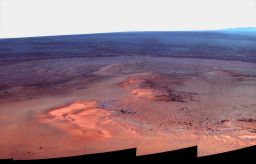 Greeley in winter
Greeley in winterThis mosaic of images taken in mid-January 2012 shows the windswept vista northward (left) to northeastward (right) from the location where Opportunity is spending its fifth Martian winter, an outcrop named Greeley Haven after MER science team member Ron Greeley who passed away unexpectedly in October 2011. The rover used her panoramic camera (Pancam) to take the component images as part of full-circle view being assembled from Greeley Haven. The view includes sand ripples and other wind-sculpted features in the foreground and mid-field. The northern edge of the the Cape York segment of the rim of Endeavour Crater forms an arc across the upper half of the scene.
Credit: NASA / JPL-Caltech / Cornell / ASU
Winds during winter on Mars? In the past, Opportunity has not experienced any winds during winters to write home about.
"The gusts are unpredictable and you're going to catch them when you catch them," Squyres acknowledged. "On thing to realize though is that we're in a very different location geographically now than we have been for every other winter, every other season of the Opportunity mission. For years, we were out on the plains, and the plains are the plains, are the plains, as far as the wind is concerned, as far as we know.
"Now, we're on the rim of this great big crater, and it's going to have influence on the airflow, the wind patterns, and on what we're going to get," Squyres continued. "All bets are off in terms of being able to predict when and where a gust is going to happen, so we just wait and hope."
Waiting and hoping has paid off in the past, and team members are hoping it will continue to reap windy rewards. "It's been good news the past few days," Squyres said, "but either way with spring coming, we'll be on the move again at some point in the future."
Theoretically, Opportunity could drive tomorrow. "But we want to stay on tilted [slopes] to maintain these energy levels," reminded Arvidson. "If for some reason a drive faults out and we're on a south-facing slope, we have to take that into account." More than that, "radio science became the most important thing to do this winter," he added. "We need to think through – when is radio science done? When are we comfortable with not being on a north-facing slope?'"
All considerations taken, Opportunity is likely to be at Saddleback for about six months, Arvison suggested, its total odometry temporarily frozen at 21.35 miles (34,361.37 meters). That puts it at two months down, four to go. "We're going through the bottom of the curve," he said. "The rover is working and we're just waiting for the spring to show up, so we can buzz on out of there."
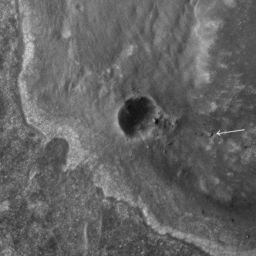 Opportunity on Endeavour's rim (detail)
Opportunity on Endeavour's rim (detail)This HiRISE image, taken on Sep. 10, 2011, shows Opportunity sitting atop some light-toned outcrops on the rim of Endeavour Crater.
Credit: NASA / JPL / University of Arizona
The MER science team has a "pick list" of things to get done before Opportunity leaves Cape York, "a pretty short list," said Squyres.
"We want to look at a few more veins," he said. "And, we saw two different kinds of breccias to the south of Cape York, and I'd love to find a contact between those two, that would be a valuable thing geologically."
That's about it. The smectite, clay minerals, seen in orbital data to the south are beckoning.
"Of course, if something wonderful pops up in front of us at Cape York, then as usual all bets are off," said Squyres. "We will stop in our tracks and deal with it."
All that noted, Opportunity has been at Cape York since last August, and "Endeavour is a big crater," as Squyres put it. "Once we have the ability to move we're going to want to move," he acknowledged. "There's wonderful stuff to the south."
For now, as Opportunity works away digging into Year 9 of exploring Mars, all is well on the Red Planet. The darkest clouds in the solar system these days appear to be the ones over Washington, roiling from budget cuts, thundering with an astounding lack of vision.
Let’s Go Beyond The Horizon
Every success in space exploration is the result of the community of space enthusiasts, like you, who believe it is important. You can help usher in the next great era of space exploration with your gift today.
Donate Today

 Explore Worlds
Explore Worlds Find Life
Find Life Defend Earth
Defend Earth


